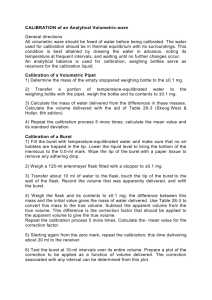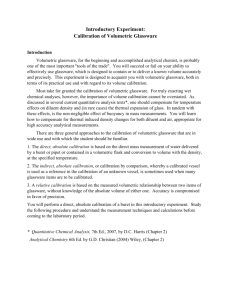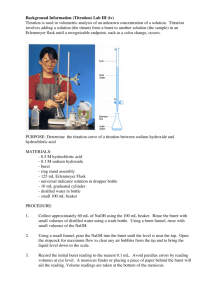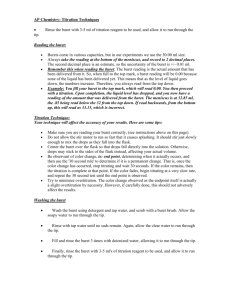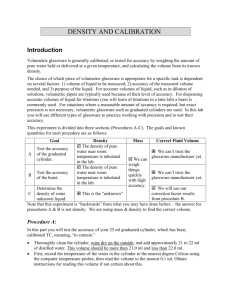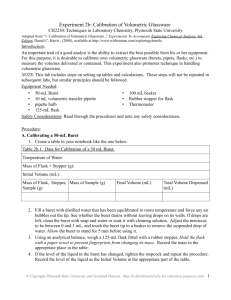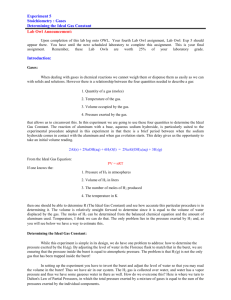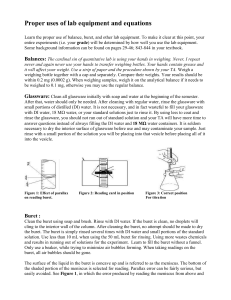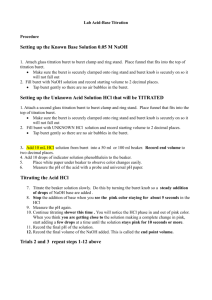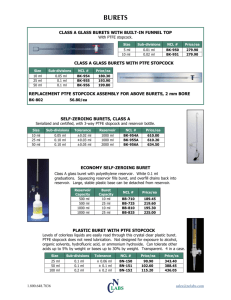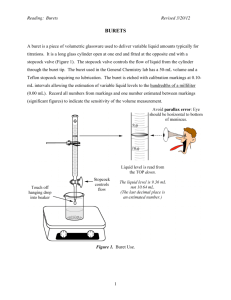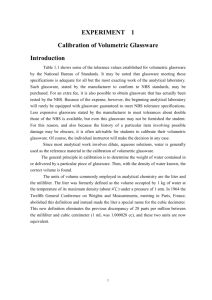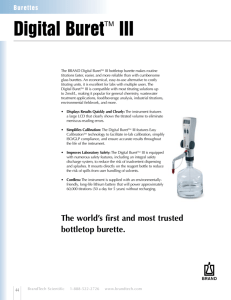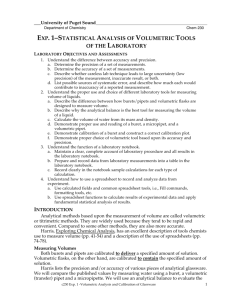CH2212 Calibration of Volumetric Glassware
advertisement
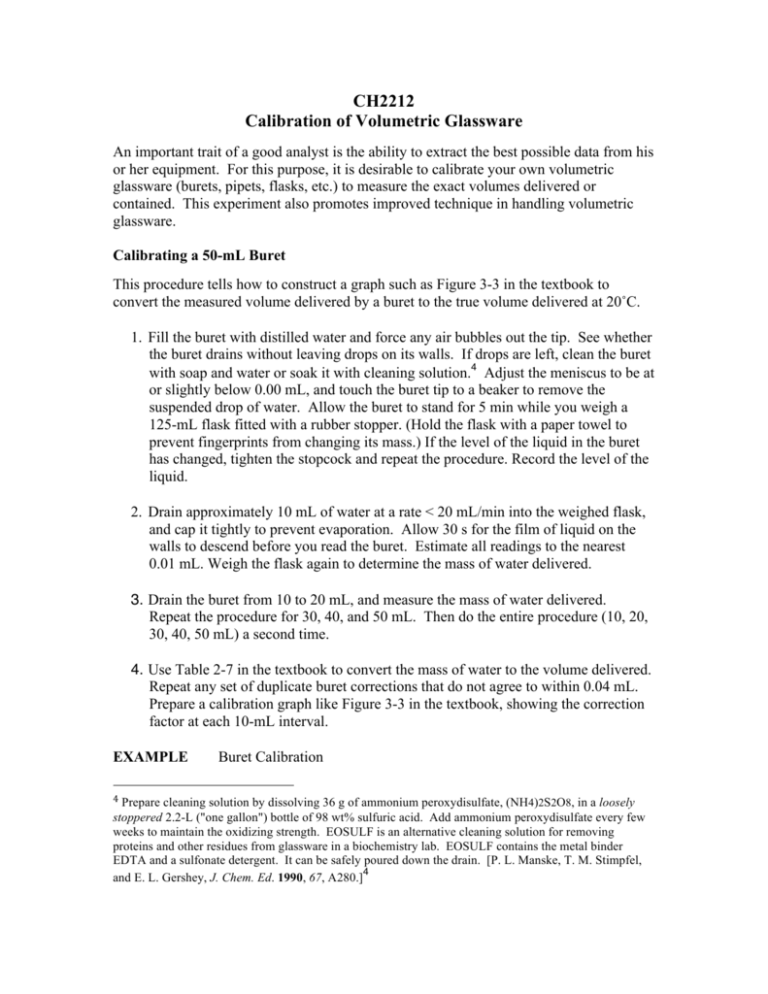
CH2212 Calibration of Volumetric Glassware An important trait of a good analyst is the ability to extract the best possible data from his or her equipment. For this purpose, it is desirable to calibrate your own volumetric glassware (burets, pipets, flasks, etc.) to measure the exact volumes delivered or contained. This experiment also promotes improved technique in handling volumetric glassware. Calibrating a 50-mL Buret This procedure tells how to construct a graph such as Figure 3-3 in the textbook to convert the measured volume delivered by a buret to the true volume delivered at 20˚C. 1. Fill the buret with distilled water and force any air bubbles out the tip. See whether the buret drains without leaving drops on its walls. If drops are left, clean the buret with soap and water or soak it with cleaning solution.4 Adjust the meniscus to be at or slightly below 0.00 mL, and touch the buret tip to a beaker to remove the suspended drop of water. Allow the buret to stand for 5 min while you weigh a 125-mL flask fitted with a rubber stopper. (Hold the flask with a paper towel to prevent fingerprints from changing its mass.) If the level of the liquid in the buret has changed, tighten the stopcock and repeat the procedure. Record the level of the liquid. 2. Drain approximately 10 mL of water at a rate < 20 mL/min into the weighed flask, and cap it tightly to prevent evaporation. Allow 30 s for the film of liquid on the walls to descend before you read the buret. Estimate all readings to the nearest 0.01 mL. Weigh the flask again to determine the mass of water delivered. 3. Drain the buret from 10 to 20 mL, and measure the mass of water delivered. Repeat the procedure for 30, 40, and 50 mL. Then do the entire procedure (10, 20, 30, 40, 50 mL) a second time. 4. Use Table 2-7 in the textbook to convert the mass of water to the volume delivered. Repeat any set of duplicate buret corrections that do not agree to within 0.04 mL. Prepare a calibration graph like Figure 3-3 in the textbook, showing the correction factor at each 10-mL interval. EXAMPLE Buret Calibration 4 Prepare cleaning solution by dissolving 36 g of ammonium peroxydisulfate, (NH 4)2S2O8, in a loosely stoppered 2.2-L ("one gallon") bottle of 98 wt% sulfuric acid. Add ammonium peroxydisulfate every few weeks to maintain the oxidizing strength. EOSULF is an alternative cleaning solution for removing proteins and other residues from glassware in a biochemistry lab. EOSULF contains the metal binder EDTA and a sulfonate detergent. It can be safely poured down the drain. [P. L. Manske, T. M. Stimpfel, 4 and E. L. Gershey, J. Chem. Ed. 1990, 67, A280.] When draining the buret at 24˚C, you observe the following values: Final reading 10.01 10.08 mL Initial reading 0.03 Difference 9.98 10.04 mL Mass 9.984 10.056 g 0.04 Actual volume delivered 10.02 10.09 mL Correction +0.04 +0.05 mL Average correction +0.045 mL To calculate the actual volume delivered when 9.984 g of water is delivered at 24˚C, use the conversion factor 1.003 8 mL/g in Table 2-5 of the textbook. We find that 9.984 g occupies (9.984 g)(1.003 8 mL/g) = 10.02 mL. The average correction for both sets of data is +0.045 mL. To obtain the correction for a volume greater than 10 mL, add successive masses of water collected in the flask. Suppose that the following masses were measured: Volume interval (mL) Mass delivered (g) --------------------------------------------------------------------------------------0.03–10.01 9.984 10.01–19.90 9.835 19.90–30.06 10.071 Sum 30.03 mL 29.890 g --------------------------------------------------------------------------------------The total volume of water delivered is (29.890 g)(1.003 8 mL/g) = 30.00 mL. Because the indicated volume is 30.03 mL, the buret correction at 30 mL is –0.03 mL. What does this mean? Suppose that Figure 3-3 in the textbook applies to your buret. If you begin a titration at 0.04 mL and end at 29.00 mL, you would deliver 28.96 mL if the buret were perfect. Figure 3-3 tells you that the buret delivers 0.03 mL less than the indicated amount; so only 28.93 mL was actually delivered. To use the calibration curve, either begin all titrations near 0.00 mL or correct both the initial and the final readings. Use the calibration curve whenever you use your buret. Calibrating Other Glassware Other volumetric glassware can also be calibrated by measuring the mass of water they contain or deliver. Glass transfer pipets and plastic micropipets can be calibrated by weighing the water delivered from them. A volumetric flask can be calibrated by weighing it empty and then weighing it filled to the mark with distilled water. Perform each procedure at least twice. Compare your results with the tolerances listed in tables 23 and 2-4 in Chapter 2 of the textbook.


